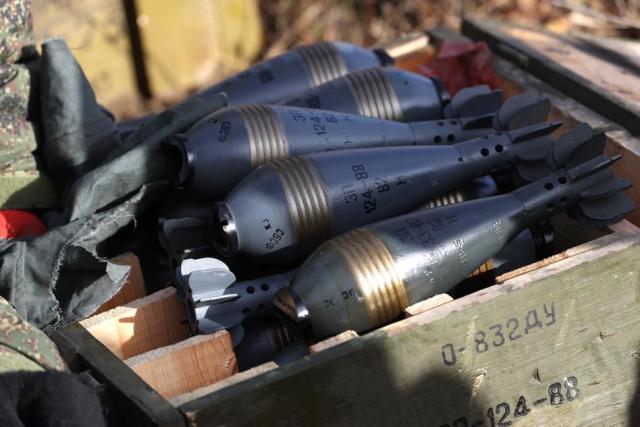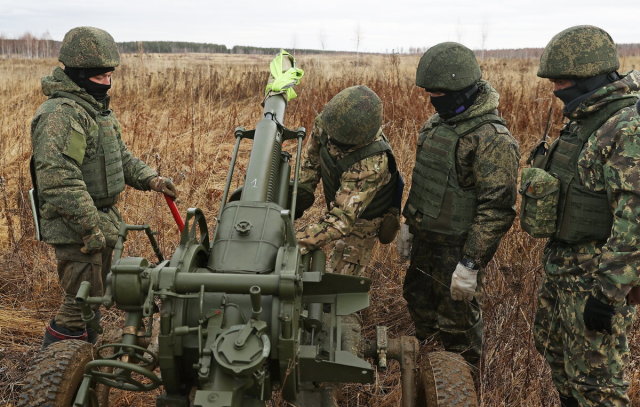The Ministry of Defense of the Russian Federation has published footage of the combat work of the 2B9 "Cornflower" mortar, the calculation of which destroyed the enemy stronghold with personnel. TASS tells about the world's only mass-produced automatic mortar
The message of the Russian military department tells about the actions of the servicemen: after a sighting shot and amendments, the gunners fired a volley of fragmentation mines from a Cornflower camouflaged in the forest, as a result of which the target was eliminated.
"We are working on enemy manpower, lightly armored vehicles. We are "dismantling" the evacuation, the cars, — said the senior gunner of the mortar with the call sign Ensign. "The advantages of [the mortar] are that we can send four mines at once without restoring the guidance, because the guidance does not go astray."
In another episode of combat work shown, the mortar men use the tactics of a "nomadic gun" — a rapid advance and a rapid change of firing position. At the same time, the mortar, respectfully called "Vasily Vasilyevich" in the troops, clings to an army truck. In addition, 2B9S are mounted on MT-LB multi-purpose light armored tractors. This not only increases the mobility of the calculation, but also allows you to use off-road as a position. Both observers and operators of unmanned aerial vehicles correct the fire.
82 mm automatic rifle
Automatic smoothbore mortar 2B9 "Cornflower" 82 mm caliber began to be created shortly after the end of World War II. The developer of its prototypes was Viktor Filippov, who later became the chief designer of the Design Bureau of Transport and Chemical Engineering (KB THM), an enterprise developing refueling equipment for rocket and space technology. The solutions incorporated in Filippov's developments are the basis of equipment for modern rocket launch complexes.
 |
| 82 mm shells for self-propelled automatic smoothbore mortar 2B9 "Cornflower". |
| Source: Donat Sorokin/ TASS |
Initially, an automatic mortar using recoil energy for automation was intended to be placed in fortifications, therefore it received the abbreviation KAM ("casemate automatic mortar"). The field version of the automatic mortar was also ready, but its modified version 2B9 "Cornflower" was adopted only in 1970. In the mid-1950s and 1960s, the development of artillery in the USSR was not given due importance — Soviet leader Nikita Khrushchev believed that with a powerful nuclear shield, the Soviet Union did not need a multimillion-dollar army and "classic" types of weapons.
The modern towed "Cornflower", according to open sources, has a mass of more than 600 kg and is powered by cassettes for four mines. The combat rate of fire of the mortar reaches 120 rounds per minute, technical — 170. The first version of the "Cornflower" could fire projectiles at a rate of up to 300 rounds per minute. To prevent the barrel from overheating, its water cooling was used. Then the rate of fire of the weapon was lowered, but the cooling was replaced with air: the temperature of the barrel was lowered by a special fin. This modification received the index 2B9M — it is she who is the most modern. The mortar is capable of hitting targets at a range of over 4 km.
In artillery, direct fire and from closed firing positions are distinguished. In the first case, the gunner directly observes the target, which, as a rule, is located near the gun. At the same time, the accuracy of shooting increases, the consumption of ammunition decreases. Shooting from a closed position, when the calculation of the gun does not see the target, can be carried out for a long range, and in the zone of its correction of fire and target damage control are often performed by unmanned aerial vehicles.
"The Cornflower mortar <...> participated in various conflicts, including in Afghanistan, in the Chechen campaigns and is now in the zone of a special military operation. And it shows itself from a fairly good side," said Yuri Knutov, a military expert, director of the Museum of Air Defense Forces, in an interview with TASS. "This mortar is probably the only one in the world that allows direct fire, and not just a canopy," he said.
Yuri Knutov
military expert
"At its core, this is a smoothbore 82 mm automatic cannon, which uses standard small O-832DU mines as ammunition. The mine weighs 3.4 kg, carries 400 g of TNT," Alexey Sakantsev, a reserve officer of the rocket forces and artillery, a veteran of military operations, shared his opinion with TASS.
The specialist noted a number of operational disadvantages of the mortar: the danger of a mine falling near the mortar when it misfires due to the design features of automation, the need for careful wiping and washing of ammunition before equipping cassettes, which can be difficult in the winter season.
The Afghan "broom"
The use of a mortar with a mobile chassis began long before the special military operation — even during the fighting in Afghanistan. The author of such a development was Major Alexander Metla, who served as part of the 56th separate airborne assault brigade, now a colonel in the reserve.
"Arriving in Afghanistan, I noticed that most often the battalions of our brigade suffer losses in the same place," he said in an interview with the newspaper Krasnaya Zvezda. — The shelling of the "spirits" columns, as a rule, was conducted from the bed of a dried-up river." Then the fire suddenly stopped, and the militants retreated by secret paths. A firing device was required that could quickly throw mines at an enemy ambush. Broom suggested placing a quick-firing "Cornflower" in the back of an army truck "Ural" on the bed of an anti-aircraft installation so that it would be possible to conduct a round-fire. The impromptu installation received its baptism of fire at the first escort of a military column.
Alexander Broom
Colonel of the reserve
Broom said that the installation with the ability to quickly change the direction of fire pleased the servicemen. During the major's Afghan business trip, several samples of such a complex were made, the soldiers successfully fought on them and received awards. The "broom" also covered the withdrawal of Soviet troops from the territory of the country.
Foreign tour "Cornflower"
In the 1990s, according to the American magazine The National Interest, Chinese gunsmiths acquired a license from Russia to manufacture this mortar. As a result, according to journalists, more Chinese "Cornflowers" under the designation W99, intended for arming mountain brigades, were produced than in the USSR. Then engineers from China upgraded Soviet weapons: the SM-4 variant received an elongated barrel, a ballistic computer, and began using heavier mines.
"The rate of fire of the Cornflower can pose a significant threat to American troops in the event of its supply to the enemy," the American magazine The National Interest expresses concern . — "Cornflower" is capable of overloading modern missile and mine defense systems (C-RAM) used to protect American bases in Iraq, forcing them to quickly spend ammunition. <...> The use of "Cornflower" as an assault weapon poses a much higher danger than other weapons firing high-explosive shells, so as the first salvo will become much more deadly."
The US Armed Forces are trying to develop their own automatic mortar with low recoil, suitable for installation on vehicles. In particular, the Ground Forces installed a Cornflower in the back of an army SUV HMMWV, but it did not go further than experiments. The ADIM project (Automated Direct Indirect-fire Mortar — "Automatic mortar of direct-indirect fire") is also stalling. Within its framework, an 81-millimeter 20-charge mortar with computer control was mounted on the same HMMWV. However, the weapon was considered too expensive for further work.
Decades after the appearance of the domestic automatic mortar with a floral name remains the only mass-produced weapon of this class and continues to successfully perform combat missions.
Victor Bodrov

